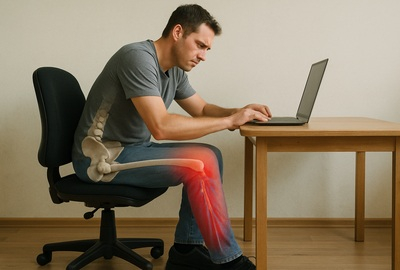- The Real Answer to What Makes a Chair Ergonomic
- 1. What Makes a Chair Ergonomic: Key Features Explained
- 2. Why Adjustable Seat Height Is the Foundation of a Chair Ergonomic Setup
- 3. Benefits of Using a Good Ergonomic Chair
- 4. How Adjustable Seat Depth Improves Comfort and Circulation
- 5. Choosing an Ergonomic Office Chair with Adjustable Armrests
- 6. Adjustable Backrest Support: The Backbone of Ergonomic Chair Features
- 7. Chair Explained: Breaking Down What Makes a Chair Ergonomic
- 8. Ready to Upgrade? Find Your Perfect Ergonomic Chair Today
The Real Answer to What Makes a Chair Ergonomic
If you’ve ever finished a workday with a sore back, stiff neck, or numb legs, you’ve likely asked yourself: What makes a chair ergonomic? It’s not just a fancy label or premium pricing—it’s about how well a chair supports the human body during extended periods of sitting.
An ergonomic chair is specifically designed to promote a healthy sitting posture, offering features that allow you to adapt the chair to your unique body dimensions and working habits. From seat height to lumbar support, these aren’t optional upgrades—they’re essential tools for comfort, productivity, and long-term health.
1. What Makes a Chair Ergonomic: Key Features Explained
The phrase “what makes a chair ergonomic” often gets thrown around without clarity. A proper ergonomic chair is purpose-built to support your body’s natural posture during long hours at a desk. Unlike a basic office chair, an ergonomic one aligns the spine, supports the shoulders, and encourages healthy blood circulation.
Here are the must-have ergonomic chair features:
- Adjustable seat height, seat depth, armrests, and backrest
- Proper lumbar support
- Encourages even weight distribution
- Supports upper body alignment
- Promotes a relaxed and neutral position
These ergonomic features are not simply about comfort—they’re engineered to prevent physical damage and support correct posture from head to toe.
2. Why Adjustable Seat Height Is the Foundation of a Chair Ergonomic Setup
Adjustable seat height is the starting point. It ensures your feet flat on the floor, thighs parallel to the ground, and knees at a 90-degree angle. If your seat is too high, you’ll lose correct blood circulation in your legs. Too low, and your back takes the hit.
What to look for:
- A smooth pneumatic adjustment lever
- Height range that suits different leg lengths
- Ability to maintain a neutral position with the desk height
The optimal seat height positions your hips just slightly above your knees, creating a strong foundation to sit properly. This supports your lower back and keeps your weight evenly distributed. This is how a chair ergonomic by design adapts to different users and working setups.
3. Benefits of Using a Good Ergonomic Chair
There’s a real-world difference between sitting on a standard office chair and using a good ergonomic chair. Beyond comfort, it’s about preventing long-term damage.
Benefits include:
- Maintaining proper posture through long work sessions
- Reducing risks of repetitive strain injuries
- Improving focus with fewer distractions from discomfort
- Supporting the spine’s natural curve
- Ensuring proper lumbar support for the lower back
A high quality ergonomic chair may cost more upfront, but the health benefits outweigh the price—especially if you're sitting for extended periods.
A good ergonomic chair provides proper support for your spine, allowing you to maintain good posture even during prolonged sitting. Over time, this helps reduce fatigue, improve focus, and preserve joint health.
4. How Adjustable Seat Depth Improves Comfort and Circulation
Adjustable seat depth is one of the most overlooked but critical adjustable features. The seat pan should support your thighs without cutting into the back of your knees.
Signs of proper seat depth:
- A 2–3 finger space between seat edge and knees
- Even support along your thighs for correct blood circulation
- Fits your body dimensions without forcing posture
Pair this with the right seat material and seat width, and you've got a setup that reduces pressure and boosts daily comfort.
5. Choosing an Ergonomic Office Chair with Adjustable Armrests
Adjustable armrests do more than cradle your elbows—they guide overall arm movement and prevent shoulder tension. Without them, your arms parallel to the desk might be tough to maintain.
Key benefits:
- Keeps shoulders relaxed
- Allows proper placement of user's arms
- Supports upper body alignment and movement
If you use a keyboard, mouse, or graphic tablet daily, adjustable armrests help reduce tension from static positions and repetitive motion.
6. Adjustable Backrest Support: The Backbone of Ergonomic Chair Features
The adjustable backrest is the spine of an ergonomic setup—literally. It should support the lumbar spine and encourage movement through dynamic sitting.
Must-haves:
- Adjustable lumbar support to match your back curve
- Recline function with a locking mechanism
- Flexibility to switch sitting position throughout the day
For good lumbar support, the backrest should align closely with the curve of your lower back. When this alignment is right, it enhances the user's posture and reduces long-term spinal stress.
Poor backrest design is a direct route to poor posture. Look for chairs that move with you and offer adequate support for the full upper body.
7. Chair Explained: Breaking Down What Makes a Chair Ergonomic
Here’s the chair explained simply: it either supports the human body or it doesn’t. There’s no middle ground. If a chair lacks essential features, it’s just a padded seat.
To clarify what truly makes a chair ergonomic, ask:
- Does it adapt to different body dimensions?
- Does it support a healthy seated position?
- Can it be customized with adjustable seat height, armrests, backrest, and seat depth?
- Does it offer lumbar adjustment for lower back health?
When a chair meets the standards of ergonomics, it isn’t just adjustable—it’s adaptable. The right chair adjusts to your work style and posture habits, allowing the user comfortably to move, stretch, and recline without strain.
8. Ready to Upgrade? Find Your Perfect Ergonomic Chair Today
Upgrading to the right ergonomic office chair doesn’t need to be complicated. What matters is finding one that fits you—and not the other way around.
Checklist for your next chair:
- High end ergonomic chairs with real adjustability
- True ergonomic chairs support for the lumbar and spine
- Proper weight distribution and support for long periods
- Features like adjustable seat depth, adjustable seat height, and breathable materials
- Support for active sitting to reduce fatigue
Whether you work from home, in a shared office, or outfitting a full commercial space, you deserve more than a seat. You deserve support. Start by exploring ergonomic options that check all the boxes—then rest comfortably knowing your setup’s got your back.
And if you're looking to enhance your chair with the right tools, Deskup offers a full range of ergonomic accessories—from monitor risers to footrests and standing desks—all designed to support proper posture and reduce fatigue. Everything is stocked in Australia for fast dispatch, so you can upgrade your workspace without delay.


 Buy Now, Pay Later
Buy Now, Pay Later Verified Rating
Verified Rating 




